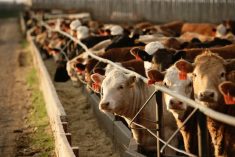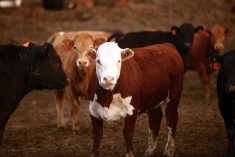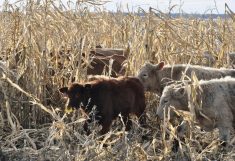In beef production, finding a balance between feed costs and environmental health takes continuous navigation.
Feed is one of the highest on-farm costs and when the price of barley, corn and wheat rises, producers often turn to using dried distillers grains (DDGs) in their rations. While this ethanol co-product lowers methane production in cattle by as much as 16 per cent, its high protein content results in more nitrogen emissions.
“Our research shows that when corn and wheat DDGs are included in diets for finishing cattle as an energy source, methane is reduced but there is a dramatic increase in nitrogen excretion in both urine and feces,” said Karen Beauchemin, a scientist in ruminant nutrition at Agriculture and Agri-Food Canada’s Lethbridge Research Station.
Read Also

Moo translator and methane measures: There’s an app for that
Dalhousie University researchers use artificial intelligence to create new dairy farm apps that analyze cattle sounds and measure methane.
DDGs in the diet also increase phosphorus content in manure, she added.
To counter the increased nitrogen excretion levels, Beauchemin supplemented the corn DDG-based diets with condensed tannins, which bind excess protein in the gastrointestinal tract.
“Adding 2.5 per cent condensed tannins to beef cattle fed finishing diets containing corn DDG reduced urinary urea nitrogen excretion and improved the retention of nitrogen in manure, with less potential for volatilization or run-off,” said Beauchemin.
This process shifted the route of nitrogen excretion from urine to feces, increasing the capture of excess nitrogen in manure. The nitrogen-containing manure, if spread properly, could help improve soil fertility, while lessening the beef sector’s environmental footprint.
However, at present, the cost savings from using DDGs are lost because of the cost of tannins, said Beauchemin, although new inexpensive sources of tannins are being explored by the team.
The research also found feeding corn DDG or fat-supplemented wheat DDG reduced the amount of methane produced in the animal’s rumen. Lower methane levels were a direct offshoot of the fat content of DDGs, as wheat DDG alone (without supplemental fat) did not change the methane emission levels. This is an important finding, as several ethanol plants are extracting the oil from corn DDG, thus reducing its fat content.
Because methane is a known greenhouse gas, its production is under constant scrutiny. Produced more in cattle on a high-forage diet, methane is released into the atmosphere during the normal cud-chewing process.
Thus the balancing act. Producers must remain watchful of grain costs and weigh the practicality of adding DDGs to feed against its effect on the environment.
“There are so many variables to consider when making feed decisions, and from Dr. Beauchemin’s research, we can see it’s much more than just feed costs,” said Susan Novak, executive director of strategic initiatives with the Alberta Livestock and Meat Agency, which supported the research.















